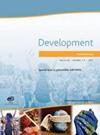The people behind the papers - Yasmine el Azhar and Ina Sonnen.
IF 3.6
2区 生物学
Q1 DEVELOPMENTAL BIOLOGY
引用次数: 0
Abstract
Hes proteins are transcription factors that are dynamically expressed during embryonic development, but it remains unclear how the oscillations in Hes expression differ across cell types during development. In this new study, Ina Sonnen and colleagues find that the Notch-driven Hes1 oscillation dynamics in the mouse embryonic tail are cell-type specific. To find out more about the story behind the paper, we caught up with first author Yasmine el Azhar and corresponding author Ina Sonnen, Group Leader at the Hubrecht Institute, The Netherlands.
报纸背后的人--亚斯明-埃尔-阿扎尔和伊娜-索南。
Hes 蛋白是胚胎发育过程中动态表达的转录因子,但目前仍不清楚发育过程中不同细胞类型的 Hes 表达振荡有何不同。在这项新研究中,Ina Sonnen及其同事发现,小鼠胚胎尾部由Notch驱动的Hes1振荡动态具有细胞类型特异性。为了进一步了解论文背后的故事,我们采访了论文的第一作者 Yasmine el Azhar 和通讯作者、荷兰 Hubrecht 研究所组长 Ina Sonnen。
本文章由计算机程序翻译,如有差异,请以英文原文为准。
求助全文
约1分钟内获得全文
求助全文
来源期刊

Development
生物-发育生物学
CiteScore
6.70
自引率
4.30%
发文量
433
审稿时长
3 months
期刊介绍:
Development’s scope covers all aspects of plant and animal development, including stem cell biology and regeneration. The single most important criterion for acceptance in Development is scientific excellence. Research papers (articles and reports) should therefore pose and test a significant hypothesis or address a significant question, and should provide novel perspectives that advance our understanding of development. We also encourage submission of papers that use computational methods or mathematical models to obtain significant new insights into developmental biology topics. Manuscripts that are descriptive in nature will be considered only when they lay important groundwork for a field and/or provide novel resources for understanding developmental processes of broad interest to the community.
Development includes a Techniques and Resources section for the publication of new methods, datasets, and other types of resources. Papers describing new techniques should include a proof-of-principle demonstration that the technique is valuable to the developmental biology community; they need not include in-depth follow-up analysis. The technique must be described in sufficient detail to be easily replicated by other investigators. Development will also consider protocol-type papers of exceptional interest to the community. We welcome submission of Resource papers, for example those reporting new databases, systems-level datasets, or genetic resources of major value to the developmental biology community. For all papers, the data or resource described must be made available to the community with minimal restrictions upon publication.
To aid navigability, Development has dedicated sections of the journal to stem cells & regeneration and to human development. The criteria for acceptance into these sections is identical to those outlined above. Authors and editors are encouraged to nominate appropriate manuscripts for inclusion in one of these sections.
 求助内容:
求助内容: 应助结果提醒方式:
应助结果提醒方式:


